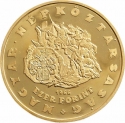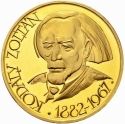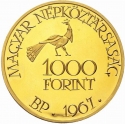You are about to finish your registration. Please check your mailbox (including spam folder). There should be a letter with a confirmation link. Check setting to make sure that your e-mail address is correct.
Send letter againDescription
The origin of screw (split) coins in Hungary traces back to the 1948-49 revolution and War of Independence. These detachable coins, commonly known as "spy coins" or screw krajcars, were utilized during and possibly after the revolution. They contained hidden messages or images of figures like Bem and Petőfi, symbolizing the revolutionary spirit. Even today, the tradition of transmitting messages holds significance. This commemorative coin pays tribute to both the historical method of message transmission and the advancements in coin production technology.
Engraver: Arany Koleszár
Obverse

|
At the upper part, Mercury (Greek: Hermes), the messenger of the gods, is portrayed with a printed circuit pattern. Below, a piece of paper displays a message encoded in binary code. The sequence of "1" and "0" digits translates to the Latin phrase "Pro Patria," meaning "For the homeland." "Pro Patria" with binary system. |
|---|---|
Reverse

|
The top right corner features the country name (Hungarian Republic), while the central field displays the denomination. At the bottom left quarter, a parabolic antenna is depicted, with the engraver's privy mark below it. In the bottom right quarter, you can find the mint mark (BP), with the year of issue situated beneath it. MAGYAR KÖZTÁRSASÁG |
| Edge |
The coin can be divided into two parts at the edge |
1000 Forint
Third Republic
Message
KM# 766 Adamo# EM182
Message







